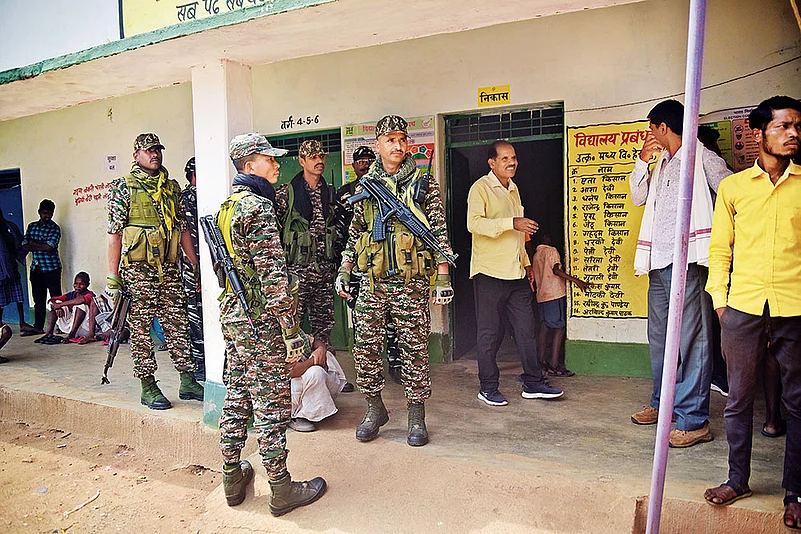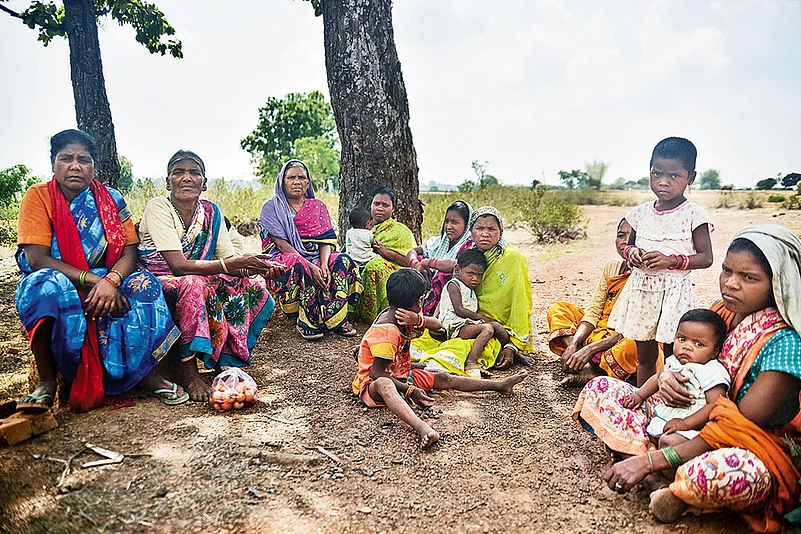They were marked as “shadow areas” in a booklet Shekhar Jamuar, DC Garhwa, opened for us. “Take a picture of this page,” he says. “Polling stations have been relocated in these areas. There will be live digital monitoring too.”
“Stick to the road’’, he adds as we set out for a week of travel across the Budha Pahad region. This area was declared “free from red terror” under the code name of Operation Octopus, by the combined forces of Jharkhand Jaguars, in September 2022. The official claim is that 5,000 people of the 27 villages of Budha Pahad region would vote for the first time in the 2024 Lok Sabha election. However, seldom does anyone from here vote on the basis of individual choice. It is almost always decided by the village elders.

We took off on our motorcycle from the newly-built Collectorate building at Medininagar, Daltonganj (constructed mainly due to the donations of the Soren government). We zipped across a newly-built road, courtesy the PM Gramin Sarak Yojana (phase 3) of the project envisioned by the Vajpayee government, and executed by the current Bhartiya Janata Party (BJP) government at the Centre. The road cuts through the hilliest terrains, and across countless tributaries of the Koyel and Auranga rivers. When we paused for a break, we found isolated houses, a lone shed, a mill worker’s angaan, a shack selling eggs. No cows or milk. No gas to boil the milk on. Even firewood is scarce. The difference between the newly-minted road and the villages on either side, some covered in thick green foliage and some lying there like barren red wounds, is stark.
Our first stop was Baresanr police station (Latehar district, Chatra Lok Sabha constituency), to get clearance to reach the village of Tisia, as we thought there was a Central Reserve Police Force (CRPF) check post there. “All the CRPF forces have been withdrawn from outposts like these, and have been put on election duty,” says the officer in charge at Baresanr. “We can’t give you permission to go on paper, but rest assured, wherever you feel that they’re watching you, someone from our side is trailing you too,” he adds.

We travelled through the forest, where we ran into two men riding a two-wheeler. They had followed us from Baresanr and were headed to the village of Kujrum, right opposite Tisia. They were labourers from Kujrum employed by the Forest Department to build a water reservoir for animals. We followed them to Kujrum (Latehar, Chatra constituency). Almost 13 km later, the forest cleared out on to a green village with just a few mud houses with thatched roofs. Smartphones have reached them. Everyone here is on Instagram. But many villagers have given up the fight against the forest department officials over the basics such as a contractual monthly wage for their labour or the option of not forcing them to serve as labourers in Kerala and Mumbai, inspite of them having their own land here. In the past, there have been many reports of clashes between the forest officials and the locals over the cutting of wood, the cultivation of crops, and the setting of borders of police jurisdiction. Tirsuram Oraon, 53, an indigenous medicine practitioner says that he’s tired of his village and its politics, “Football ban gaye hum sarkaar aur dada log ke beech!” (I’ve become a football between the government and the ‘brothers’). Tisruram wants to accept the sarkar’s offer of 5 acres of land or alternatively 15 lakh rupees to vacate his land and move to the village of Lahlahe 55 km away near Medininagar. He has gone to the DC’s office and it has been promised to him on “badka badka (big, big) laptops”, he reminisces.
We decided to skip Tisia and head to the village of Lat, 9 km away, towards Chhipadohar. It too falls in the Chatra constituency. The men had not returned from the neighbouring fields where they worked as labourers. We spent some time with the women. There was a sense of helplessness under their laughter. Smartphones have arrived here too, but they were in the hands of the men. “Vote? What vote? They tell us which button to press, and we go there and press it—it’s that simple, ‘’ says Ratna Devi. She adds, “I’ve been listening to the phrase ‘gas will come’ since I was a kid. Now I’m a grandmother. My sons still cook using firewood”. They lament how long it takes for papers to get passed by those in the government offices. This time, hardly any politicians have come here for prachaar (campaigning).

We headed to Surkain (block Mahuadanr, Palamu district), the last village on the extreme left edge of Jharkhand jutting out into Chhattisgarh, adjacent to the border. With its post office at Orsa (9 km away), the villagers of Surkain have to walk a long way to find their ration shops. “Free ration is okay but shouldn’t I get it at my doorstep?” asks Birendra Nagasia, 48, a farmer. He was a “party worker” before, but because he was responsible to get the entire village’s ration through the forests, he feared for his life and thereby quit the party. Now, with an almost ready road in place, it has become more convenient to get the village’s ration. But they often receive only 4 or 4.5 kg out of the 5 kg grain allotted. The dalals (middlemen) take advantage of the cracks in the system. Many claim their mukhiyas themselves take a cut of the pie that is the PM Awas Yojana.
At Hesatu village (Garhwa district, Palamu Lok Sabha constituency), the women come back in the afternoon with handpicked mahua. They sell them to make about forty-fifty thousand a month, said a CRPF man of the 172 Battalion posted at a polling booth that was set up in the area for the first time after 19 to 20 years of continuous boycott “by the Maoists”’ who had planted what Md Hamid Ansari, Sector Magistrate, calls their “kaala jhanda” (black flag) there. Ministers and panchayat heads turned up at Hesatu on voting day. There was the byte of the first voter, the 80-plus gram panchayat head, whom none of the local reporters were on time to capture. The polling officials repeated instructions every five minutes keeping in mind that the people there were voting after a long gap.

We also stopped by the relocated booths of Madagari and Bijka (Bhandaria Block, Garhwa district) where voters from the villages of Harta, Turer and Saneya Toli were expected to arrive. The polling officials were brought there via helicopters.
In Madgari, there was a computer operator named Alok Gupta, 27, who is from Madgari itself. When asked about Maobadi in the area, he pointed at the burnt-down buses along the road, right by the polling booth, which he says have been there for long. Madgari hosts five polling booths, but Alok is yet to visit villages like Turer that are located only a few km away into the forest. Caste plays a major role in determining who stays in the relatively flatter land, and who stays in the isolated villages up north. There is also a recently-drawn axis of division: those who stay closer to the road and those who stay further inwards. Passing through the forest villages of the Budha Pahad region, we encountered many trucks. At the base of the Netarhat plateau (block Mahuadanr, Latehar), we spotted a bauxite mine these trucks were pulling out of. There are several mines on the plateau. Due to continuous mining and movement of trucks filled with ore for the last 30 years, the land has become almost barren.

“If the area were to truly have become Maobad-free, there wouldn’t be pickets in every junction like you see here,” says Bishudeb Singh, 43. The locals build their own solar power units, and drill their own boring wells, keeping voter ids and other documents in a polythene bag with them at all times in case they are stopped at a picket.
On the occasion of Sarhuls, many Sarna samities around Bishnupur and it’s neighbouring villages come out dancing and singing in troupes. In the run-up to the elections, they seem like politically motivated events. We spotted a Sarhul and a campaign auto of the BJP fitted with loudspeakers blaring slogans during our travels.
Whatever the outcome of the 2024 Lok Sabha elections, one hopes that it translates into easing the on-ground problems of the villages in the Budha Pahad region. For the true benefits of welfare schemes and development projects to reach the villagers, they shouldn’t have to organise behind a flag.
(Abhishek Basu is a freelance photographer & Joyona Medhi is an independent researcher)
(This appeared in as A Thin Red Line)

















